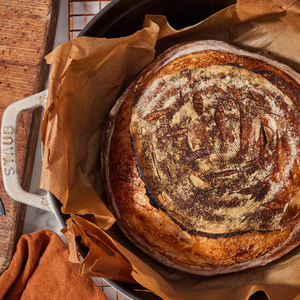Ingredients
Equipment
Method
- In a large bowl, combine the unfed sourdough starter, lukewarm water, kosher salt, and honey. Stir until the salt and honey are dissolved and the starter is mostly dispersed.
- Add the bread flour to the wet mixture. Using a strong spoon or your hands, mix until a shaggy dough forms and no dry flour remains. Do not knead excessively.
- Cover the bowl with a damp cloth or plastic wrap and let the dough rest at room temperature for 30 minutes to an hour. This allows the flour to fully hydrate (autolyse).
- Over the next 2-3 hours, perform 3-4 sets of stretch and folds every 30-45 minutes. Lightly wet your hands, grab a portion of the dough, stretch it upwards, and fold it over itself. Rotate the bowl and repeat 3-4 times per set.
- After the last set of folds, cover the dough and allow it to bulk ferment at room temperature (around 70-75°F / 21-24°C) for 6-12 hours, or until it has visibly increased in size (about 30-50%) and appears bubbly and alive.
- Gently turn the dough out onto a lightly floured surface. Lightly pre-shape into a round, cover, and let rest for 20-30 minutes.
- Shape the dough into a tight boule or batard, building tension on the surface.
- Transfer the shaped dough seam-side up into a well-floured banneton (proofing basket) or a bowl lined with a floured kitchen towel. Cover and refrigerate for 12-18 hours (cold proof).
- About an hour before baking, place a Dutch oven with its lid into your oven and preheat to 475°F (245°C).
- Carefully transfer the cold dough from the banneton into the preheated Dutch oven. Score the top of the dough with a sharp knife or razor. Bake with the lid on for 20-25 minutes, then remove the lid and continue baking for another 20-30 minutes, or until the crust is deep golden brown. Let cool completely on a wire rack before slicing.
Notes
The use of an unfed starter implies this recipe aims for a more hands-off approach, potentially with longer bulk fermentation and proofing times to allow the wild yeasts to activate fully. Ensure your water is truly lukewarm, around 75-80°F (24-27°C), to gently encourage the starter. For a superior crust and crumb, a preheated Dutch oven is indispensable for baking, trapping steam and allowing for excellent oven spring. Don't be afraid of the sticky dough; a good dough scraper and lightly floured hands are your best friends. The honey will aid in browning and add a subtle sweetness, balancing the tang of the sourdough. Adjust bulk fermentation duration based on ambient temperature and starter activity; observe the dough for signs of aeration and growth rather than strictly adhering to a clock for initial proofing.
